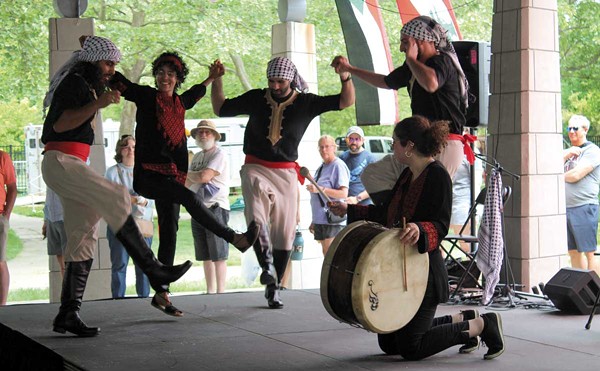Twenty or so kids shuffle into Detroit’s PuppetART Theatre like a gaggle of ducks wading into a pond. Little do they know they’re entering a magical place, a drama house where one can almost smell the global and exotic aura of Old World puppetry.
In the colorful double lobby outside the 70-seat theater, children and adults ooh and ahh at a towering display of West African carved-wood marionettes, handmade sculptures dressed in colorful cloth shirts, gathered around native instruments. The wooden musicians’ eyes look as if they could blink. Others gather around two old Chinese marionettes hanging from strings, decked in bright red and orange hats and puffy traditional dress; some are tempted to touch a Japanese puppet in a flowing silk dress with a bowl of black hair framing her alabaster skin, deep red lips and sweet black eyes as she sits in a garden set with a blossoming cherry tree and screen doors.
PuppetART’s gallery displays puppets representing many styles, from old Russia and Asia to contemporary America. Hanging from the walls, in glass cases and exhibited on sets, the puppets are infinitely intriguing, possibly because they carry an arrested animation, a real-life quality despite their wooden and synthetic bodies.
It’s not easy to find this treasure trove, though it sits just outside Detroit’s theater district, hidden in a nook along Grand River behind Compuware headquarters in downtown Detroit. The theater celebrates its 10th anniversary this year, after surviving some of the inner city’s tougher years and a dearth of local arts funding. It’s run by three Russian immigrants who brought their craft from Moscow and St. Petersburg to Detroit 15 years ago. The puppeteers make everything they need for productions, including original music, sets and the puppets themselves.
As the show begins, theater director Igor Gozman explains the meaning of the anniversary to an audience of about 50. “Detroit is a cradle of puppetry in the United States,” he says. “Not anyone would think Detroit is a place for puppetry. But it is a puppet place.”
The first national puppetry conference in the States was held in Detroit in 1936, and the city is home to one of the oldest and largest puppet societies, the Detroit Puppeteers Guild, with more than 100 members. The Detroit Institute of Arts has one of the most important puppet collections anywhere, with some hundreds of years old, currently in storage while the museum is renovated.
On Oct. 1, Gozman tells his crowd, PuppetART will host a street fair to mark its anniversary with activities, workshops and “a little parade to let people know there is a puppet theater here.”
And with that, it’s time for the show: Kolobok, a traditional Russian folk tale known stateside as The Gingerbread Man. The lights dim. A little boy with round glasses knocks his legs together and leans over the chair in front of him. A family’s seven kids crawl over one another, craning to get a clear view.
The play opens with clowns in bright clothing performing pantomime on a vibrantly decorated stage. Maybe it’s the music. Maybe it’s the pantomime. You’re no longer in downtown Detroit, but in a fanciful land far, far away. A host of puppets emerge to tell the story of a grandmother and grandfather (actors wearing oversize puppet heads) who, wishing they had a child, bake themselves a little cookie “boy.” He encounters all kinds of dangers — including a fox in a lovely green dress with sparkling jade eyes — on his path to see the wide world. The clowns work the puppets with skill, and the production is accompanied by original music, mesmerizing the audience.
After the show, a group of young adults walk out of the theater. “I was surprised and really impressed,” says Jamie Dickinson, a Wayne State University student who heard about the theater in her Russian language class. “Detroit has come a long way. We have opera, symphony and ballet, but this really adds to the culture of Detroit. I’m baffled. I’m proud that it’s here.”
Inside, one of the performers, a young Detroiter with Ukrainian roots, leans on the lobby desk, holding his guitar. “This is the real deal,” says Nick Pobutsky, one of the pantomimes and puppeteers. “It’s an ancient art form. I’m proud to be learning it. It’s stimulating intellectually and artistically. There’s a lot of life going on there, behind the stage.”
Six people keep the theater ticking: Gozman; his wife, Irina Baranovskaya, who makes the sets and puppets; Lyudmila Mikhenyenko, who directs shows; and three resident puppeteers, including Pobutsky.
Gozman studied puppetry at a university for the arts in Leningrad and met his wife in a puppet theater in Moscow. Back home, he says, puppetry is considered high art, up there with drama and opera as a necessary component of a city theater scene. Puppetry requires multiple skills — movement, acting, voice, music, stage setting and sound.
“In Russia, puppet theater is more common,” Mikhenyenko says. Her daughter composed and sang the music for Kolobok. “That’s what we’re trying to make here. Unfortunately, we don’t have enough money to make big advertisements with pictures. But we start from zero and now we have a big repertoire. We need more people, money, everything.
“But the audience, it’s month-to-month. Sometimes we have 100 people and we don’t know what to do. Schools come from Flint and Ann Arbor and all around during the week. I love it. It’s good.”
Detroit: A puppet place
Puppetry has a subversive past in traveling shows throughout Europe, Russia, India and China, and was prominent in ancient times. Though it’s gone through a family-entertainment era in American arts, in recent years puppetry has made a comeback as edgy adult entertainment.
Oddly enough, puppetry has a long history in Detroit. The first recorded show was staged in 1811, according to A History of Puppetry in Detroit (a book sold by PuppetART), and the shows were banned as immoral in 1827. Later popular shows took place in the all-male coffee shops of Greektown. During this time in the early 1900s, puppetry saw an artistic revival in the United States, led in large part by Detroit’s very own Paul McPharlin. A puppet scholar, collector, advocate, set-designer and performer, McPharlin amassed during his life one of the most important collections of global puppets. The collection was donated to the DIA after his death in 1948, and is documented in the DIA’s book, Strings, Hands, Shadows: A Modern Puppet History.
In 1929, McPharlin formed the Marionette Fellowship of Detroit, and the first annual National Puppetry Conference Festival was held here in 1936.
In the DIA book, author John Bell describes the transformation of puppetry from a tool of ritual and belief to a means of persuasion, from vaudeville to serious drama, from children’s theater to television and back. As proved by the family-oriented Muppet Show, puppetry is “capable of conveying profound artistic, social and political ideas, stories and emotions,” as Bell put it.
It’s hard to find edgy puppet theater today, though a shining example is the Red Moon Theatre in Chicago, which for years hosted an enormous Halloween event in Logan Square, and last year put on a Chinese New Year celebration. There’s also the Dreamland Theatre in Ypsilanti.
PuppetART’s artistic virtuosos, on a very limited budget, create an enchanting family experience that has much to offer adults. This year, the theater will feature a few shows geared to adults, though still children-friendly, including Crane Maiden, a Japanese tale, and Turtle Island, inspired by Native American legends. Every year, the theater presents a marionette ballet version of Cinderella with classical music. Other productions use many types of puppets and other art forms.
Money and performers to expand the theater and its repertoire are always welcome, Gozman says: “The goal is to set up a permanent theater with a resident group.
“Detroit is known for music, jazz and sports. But it’s supposed to be a puppet place. It’s not there yet. There are always struggles. I’m not going to cry about it. That’s part of the life. Nobody promised an easy way, so we live it. We want to bring the puppetry back.”
It’s the overwhelming atmosphere of Old World theater and dusty drama made new in PuppetART that might attract new artists yearning for a home stage.
Mikhenyenko says, “A lot of people come and go. Not a lot of people stay. You have to be a little crazy to work in the theater.”
The PuppetART anniversary street fair takes place Oct. 1, 10 a.m.-2 p.m., followed by a 2 p.m. performance of Kolobok; 25 E. Grand River Ave., Detroit; 313-961-7777. For season schedule and more, visit www.puppetart.org. For the Detroit Puppeteers Guild, puppet-detroit.us.
Lisa M. Collins is a freelance writer. Send comments to [email protected]




